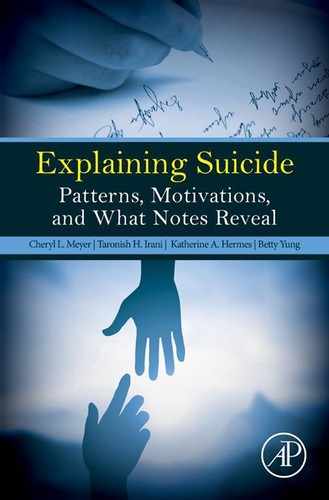Detailed Methodology
This project was initiated at the request of the Montgomery County Coroner’s Office who contacted Wright State University to see if there was any interest in carrying out a research project on suicide notes left by people determined by a coroner’s investigation to have committed suicide. The coroner’s office had been collecting these notes since 2000 but had never conducted any analysis of the contents. They were interested in having researchers examine the notes to determine if we could give them information that might prevent suicide. They approved the study and indicated their willingness to supply their data.
In addition to the notes, researchers had access to a spreadsheet containing demographic information such as name, age, gender, address of the decedent, and details of the suicide. A team of graduate students interested in the research was identified and met with faculty to review suicide note literature and to develop the system of analysis. A coding form was developed based on an extensive review of the literature concerning factors related to suicide and after a review of a subset of notes. There were five main categories: demographics; characteristics of the suicide (e.g., type of trauma); characteristics of the note (e.g., number of notes, whether it was dated, etc.); previous history (e.g., drug abuse); and the primary motivation suggested by the contents of the note. Also several areas were identified on the coding sheet where researchers could note any peculiarities of the suicide that were not coded for elsewhere.
After the initial coding sheet was developed, all researchers tested it by practicing with a small subset of three notes. This was done to determine if the coding sheet had face validity, produced interrater reliability, and was easy to use. To insure that all researchers were coding in a similar manner, definitions of each of the variables were generated by the group and available to all researchers.
The notes were randomly assigned to three teams, each consisting of three raters/coders. The coders independently analyzed each note and then met to review what had been individually coded and to seek consensus if raters disagreed on the presence or absence of a particular element. If the small group could not agree, the note was taken to the larger group for final determination. Some data on the coding sheet came from the note itself (e.g., statements about motivation) and other data from the coroner’s reports (e.g., method of death and demographics). In analyzing the notes, the raters were blind to the coroner’s data and later read and coded it only after the interrater consensus on the note had been reached. When all the note writer files had been completed, the researchers began the same process with the non-note writer files. The same coding sheet was used, with the section on characteristics of the notes deleted. When all of the data had been input into a statistical package, each file was cross-checked with the original database to insure all files were coded.
